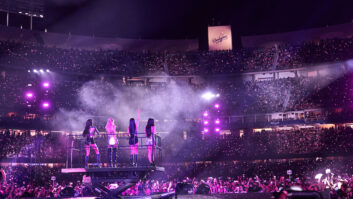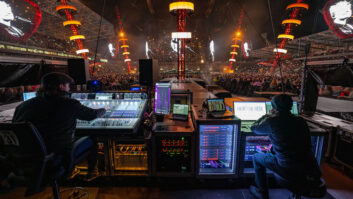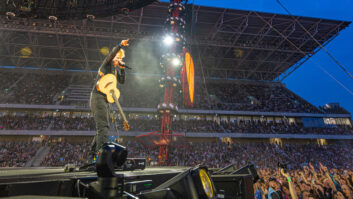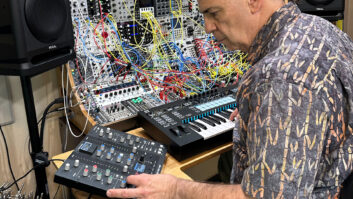Chris Brown may be one of the fastest rising acts in R&B, but with his Holiday Exclusive tour — which wraps up February 3, 2008, in Honolulu, after a two-month arena run in major U.S. markets — this teen sensation proved that he is isn’t afraid to take chances and try something new.
Performing to pre-recorded tracks is hardly unknown in the genres of rap, R&B and pop. However, for this tour, which supports Exclusive, his second album, Brown injected a novel twist by appearing on multiple synched video screens that ran clips of him acting as though he was playing bass, two guitar parts, two keyboards and a trumpet from the pre-recorded tracks. Joining these virtual players was the real-life Chris Brown singing, accompanied onstage by drummer Gerald Heyward, DJ Baby Drew and a dozen or so live dancers.
MAKIN’ PREPARATIONS
The project actually began months before the tour. Rehearsals were at the CenterStaging facilities in Burbank, Calif., where the project’s senior audio consultant, Rick Camp with J&R Audio (www.jraudio.net), worked with the tour’s front-of-house mixer and production manager, Maceo Price, and Pro Tools engineer Doug Sadler to cut the tracks to be used during the live shows. “The band was keyboards, guitar, bass, drums and DJ, so some parts were recorded live, others overdubbed and others taken straight from the record,” explains Camp. “We spent eight weeks in the regular rehearsal room, rehearsing and recording the band, and then a week on the soundstage perfecting the show at CenterStaging. There was a lot happening during rehearsals because Chris was also rehearsing for the AMA and VMA award shows and had to go overseas to do some promos in Japan and Europe while the band was still rehearsing. It was nuts.”
According to monitor engineer William “Chainey” Harpe, “One of the challenges was capturing a live feel with spontaneity and emotion when recording Chris’ original band in a rehearsal room, but everybody felt good about the Pro Tools tracks.” Rather than mix to stereo for the live playbacks, most of the tracks were kept as discrete individual channels, with some 40 Pro Tools tracks going to FOH and monitors on an “A” system and another 40 tracks on a “B” system for full redundancy. Some of it was mixed down to stems, such as the loops and special percussion tracks. These were combined with 16 channels of live drums and four channels of live DJ turntables and a 360 Systems Instant Replay.
“There are also five or six channels of vocal mics because Chris is all over the place,” adds Camp. “He has a special stand that comes up out of the elevators [on the multitiered stage].” The mics are all Shure, including KMS9 wireless for lead vocals. Other than the live inputs from the drummer, the DJ and Brown’s vocals, everything comes from Pro Tools with Brown singing backup vocals and “playing” all the instruments on video screens — with everything locked to timecode.
The video playback — and there is a lot of it — was handled by Las Vegas—based Tour Screen Productions on a Dataton Watchout system with a customized Show Sage tour rack/PC server handling picture playback/distribution of the multiple images: six 60-inch plasma displays (turned vertically) for the nearly life-size images where Brown appears to be playing the instruments. Other effects are provided using a see-through screen that flies into midstage for projecting holograms of Brown (and other artists such as T-Pain and Rhianna) and a 30×40-foot LED screen upstage hosting other images.
IN THE HOUSE
A Chris Brown provider for the past year-and-a-half, J&R Audio supplied two of the tour’s 96-channel Digidesign D-Show VENUE consoles and three Pro Tools rigs — two custom dual-playback systems and a third rig at FOH for recording the shows. Two additional 96-channel D-Show mixers — we’re talking full redundancy here — came from Clair ShowCo Chicago (formerly dB Sound), which also provided stacks and racks. The system was all Electro-Voice, with X-Line mains and Xsub subwoofers. Speaking of the subs, there were no corners cut in terms of laying down the thump, with 24 single-18 Xsubs in the air and 24 double-18 Xsubs on the ground. And 66 EVX 180B 18-inch woofers can move a lot of air.
The setup is further complicated by the use of two stages, says Camp. “There’s also a B stage that sits behind front of house. It’s a huge 30-foot circular disc that’s 20 to 30 feet high. Chris and two of his dancers perform up there, strapped to a center post because the disc rotates and tilts 60 degrees while he’s dancing. At the AMA awards, he did a dance routine while strapped upside down. This guy’s 18 years old and is not scared of anything.”
THE PRO TOOLS CONNECTION
Designed by Camp was a custom dual Pro Tools HD rig — all flightcased for protection from road torture, with two 4GB RAM, 2.66GHz Macintosh G5 systems and six Digidesign 192 interfaces — three dedicated for each system, with a total output capacity of 96 channels and 48 inputs. “During the show, I’m pretty much sending out 40 channels of the ‘band in a box’ playbacks,” says Pro Tools engineer Sadler. “We’re running two completely redundant systems: If ones goes down, the monitor and FOH consoles are preset with mute groups, so the engineers can make a near-instantaneous changeover to keep the show rocking. It’s all on a freewheel mode — jam sync — so if the ‘A’ system stops or glitches, the ‘B’ system continues to run, outputting the same audio and timecode to the FOH, monitor, video and lighting consoles.” According to Camp, this actually occurred during one performance and the changeover happened seamlessly — without losing a beat or anyone in the audience noticing the glitch.
Once it’s showtime, Sadler has a busy schedule. “I trigger every song, getting it cued up and ready while Chris is talking between numbers or taking a DJ break. But during each song, I’m getting the next one cued up and ready to go,” he explains. “I get cues from multiple people during the show — the DJ, the stage manager or the front-of-house engineer, depending on where Chris is at that moment. I’m set up below the level of the stage and can’t see what’s going on, so the video crew sends me a feed of the stage — exactly what FOH sees — so I know what Chris is doing. I supply a timecode out to lighting and video with a 2-track reference mix, so they just line up their video feeds to that, and when I hit Play everything happens. They slave to my timecode, and there’s a 1.5-second pickup [pre-roll] and then the video goes live.”
When asked about how it feels to be the one guy the entire show depends on, Sadler shrugs it off. “It feels like the world’s on me,” he says with a laugh, “but it’s definitely a team thing with the four of us — myself, Chainey, Maceo, Rick. We had a plan and it’s all come together.”
OVER IN MONITORLAND
With some 18 monitor mixes to create — for Brown, the drummer and the DJ — monitor mixing is different from the usual tour. “I’ve got nothing on the deck — there are no wedges for this show, so all the cabinets I’m using for monitors are in the air, except for some subs. I’ve got flown medium line array sidefills and then a small line array center cluster that’s thrown out of phase because the set is three layers high,” says monitor engineer Harpe. “Chris is on in-ears — the dancers are not — and I’ve got full three-way fills for [drummer] Gerald Heyward and the DJ, and they’re also on in-ears. So from event to event, I’ve got a lot of flexibility, especially for the drummer, who has a small Yamaha 03R digital mixer that allows him to do some automation on his own. He’s got a click track coming back to him, along with some Pro Tools stem channels and submixes of Chris’ lead vocals, the band tracks and a talkback to the Pro Tools engineer and the DJ in case they want to make any changes during the show. This lets him tweak his mix and store the changes for the next night.”
But mixing monitors on this tour can definitely present a few other challenges. “The sidefills are there for the dancers, but also for Chris, who will often pull one — or both — of his earpieces out, even if he’s perfectly satisfied with his in-ear mix. He just loves to be out in the thick of it all,” Harpe continues. “I remember the first time I introduced him to audience mics for his in-ear mixes. He liked it, but with all the screaming he gets from his fans I have to keep one hand on the audience mic feeds at all times, especially during ballads where he may go to the edge of the stage and reach out to a girl. Suddenly, I have 119 dB of female screams and I have to turn that down or he won’t hear another note for another 30 seconds.”
With two stages, live and recorded performances, four 96-channel D-Show VENUE consoles, two 48-channel Pro Tools systems (for playback), a 96-channel Pro Tools recording rig, multiple video feeds routed to eight onstage screens, a dozen dancers and flamethrower pyrotechnics, Brown’s Holiday Exclusive tour was one complicated production. “It’s an interesting show,” says Harpe. “It’s a different approach and we’re all excited about making sure everything works day in and day out.” True, it’s not your typical tour, but for the crew that made it happen, it’s just another day at the office.
George Petersen is the executive editor of Mix.







